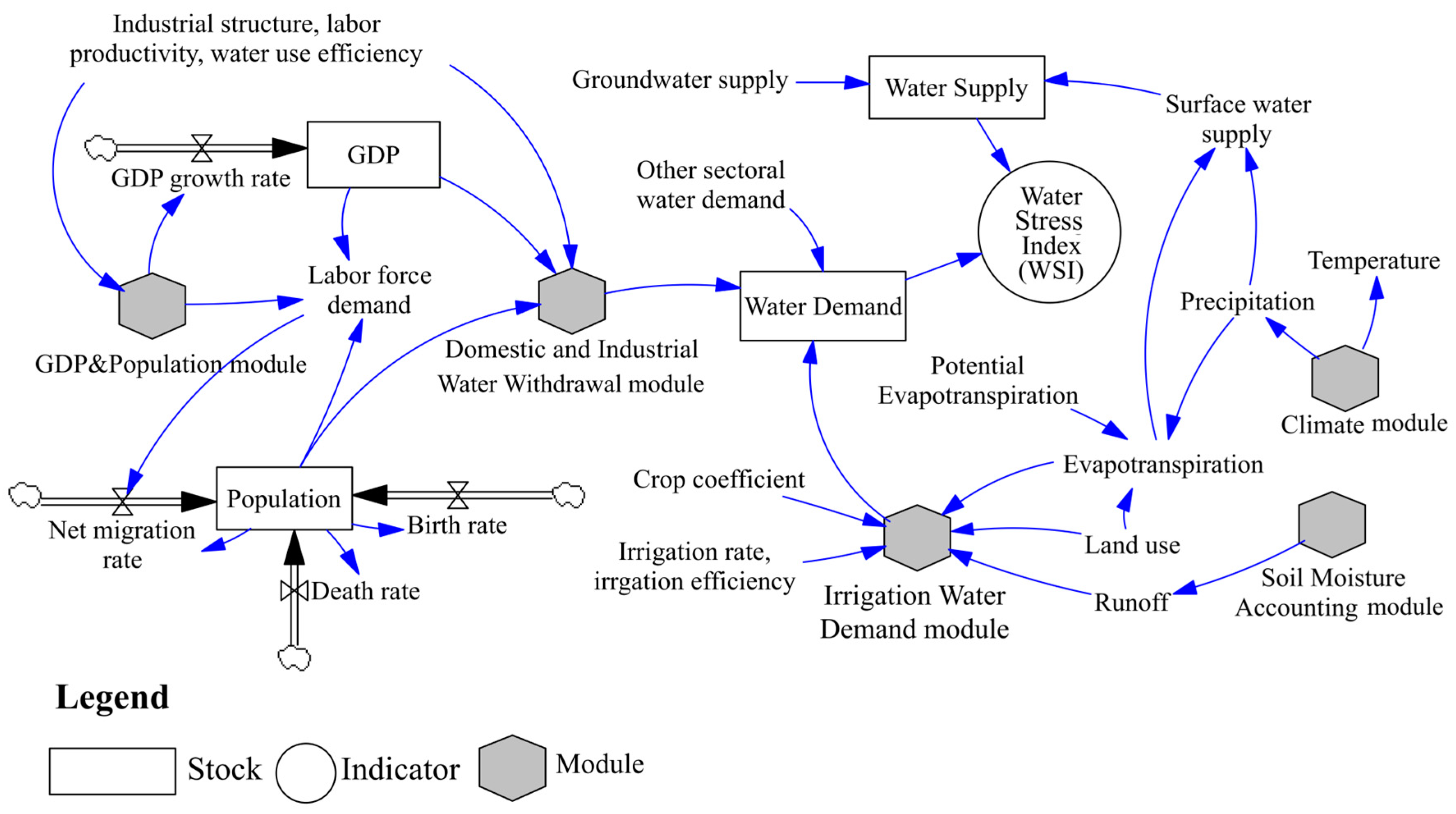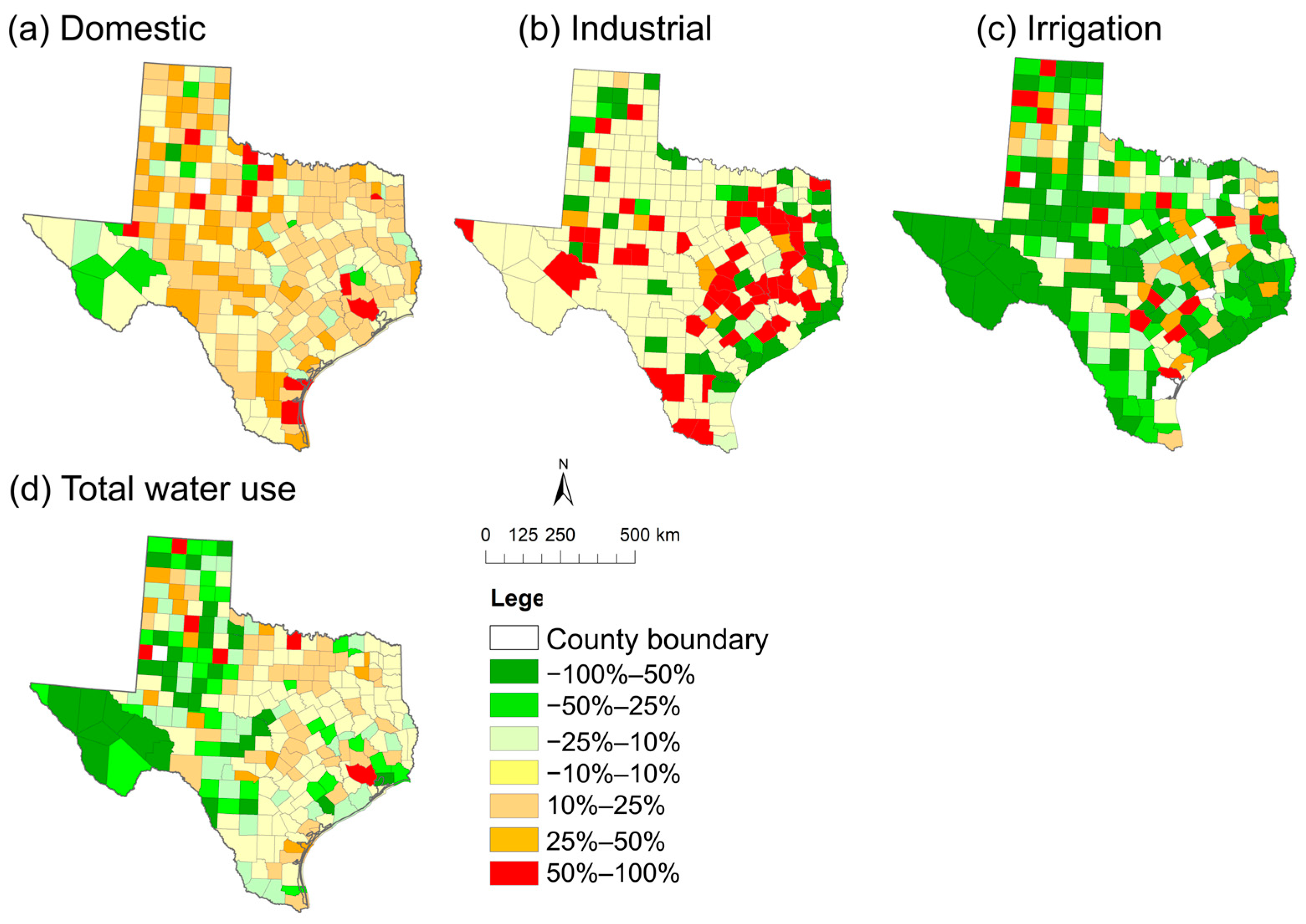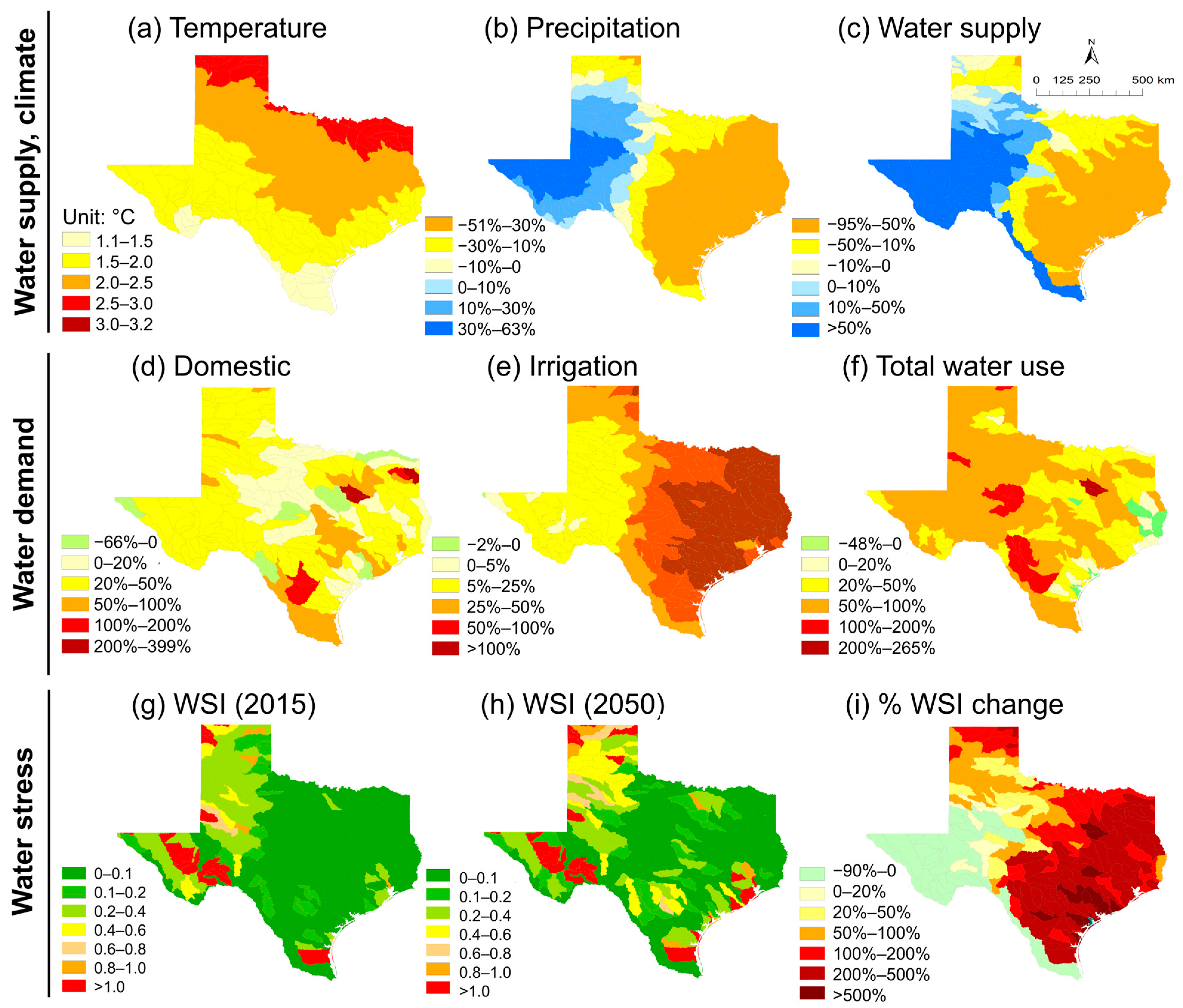Regional Water Stress Forecasting: Effects of Climate Change, Socioeconomic Development, and Irrigated Agriculture—A Texas Case Study
Abstract
1. Introduction
2. Methods
2.1. Integrated SyDWEM-WaSSI Model
2.2. Water Use from Different Sectors
2.2.1. Domestic and Industrial Water Use
2.2.2. Irrigation Water Use
2.2.3. Model Validation
2.3. Scenarios
3. Results
3.1. Base Scenario
3.2. Sensitivity Analysis
4. Discussion
4.1. Policy Implications
4.2. Advantages and Limitations
5. Conclusions
Supplementary Materials
Author Contributions
Funding
Institutional Review Board Statement
Informed Consent Statement
Data Availability Statement
Acknowledgments
Conflicts of Interest
References
- Singh, V.P.; Su, Q. Water: How Secure Are We under Climate Change? In Sustainability of Water Resources: Impacts and Management; Yadav, B., Mohanty, M.P., Pandey, A., Singh, V.P., Singh, R.D., Eds.; Springer International Publishing: Cham, Swizterland, 2022; pp. 3–24. [Google Scholar]
- Nemati, M.; Tran, D. The Impact of COVID-19 on Urban Water Consumption in the United States. Water 2022, 14, 3096. [Google Scholar] [CrossRef]
- Abu-Bakar, H.; Williams, L.; Hallett, S.H. Quantifying the impact of the COVID-19 lockdown on household water consumption patterns in England. NPJ Clean Water 2021, 4, 13. [Google Scholar] [CrossRef]
- Ober, J.; Karwot, J. The Effect of Publicly Available COVID-19 Information on the Functioning of Society, Businesses, Government and Local Institutions: A Case Study from Poland. Int. J. Environ. Res. Public Health 2023, 20, 2719. [Google Scholar] [CrossRef] [PubMed]
- IPCC. Climate Change 2021: The Physical Science Basis. Contribution of Working Group. I to the Sixth Assessment Report of the Intergovernmental Panel on Climate Change; Cambridge University Press I: Cambridge, UK, 2021. [Google Scholar]
- Su, Q.; Dai, H.C.; Lin, Y.; Chen, H.; Karthikeyan, R. Modeling the carbon-energy-water nexus in a rapidly urbanizing catchment: A general equilibrium assessment. J. Environ. Manag. 2018, 225, 93–103. [Google Scholar] [CrossRef] [PubMed]
- Qin, H.P.; Su, Q.; Khu, S.T. Assessment of environmental improvement measures using a novel integrated model: A case study of the Shenzhen River catchment, China. J. Environ. Manag. 2013, 114, 486–495. [Google Scholar] [CrossRef]
- Heinke, J.; Muller, C.; Lannerstad, M.; Gerten, D.; Lucht, W. Freshwater resources under success and failure of the Paris climate agreement. Earth Syst. Dynam. 2019, 10, 205–217. [Google Scholar] [CrossRef]
- Wada, Y.; Florke, M.; Hanasaki, N.; Eisner, S.; Fischer, G.; Tramberend, S.; Satoh, Y.; van Vliet, M.T.H.; Yillia, P.; Ringler, C.; et al. Modeling global water use for the 21st century: The Water Futures and Solutions (WFaS) initiative and its approaches. Geosci. Model. Dev. 2016, 9, 175–222. [Google Scholar] [CrossRef]
- Stenzel, F.; Greve, P.; Lucht, W.; Tramberend, S.; Wada, Y.; Gerten, D. Irrigation of biomass plantations may globally increase water stress more than climate change. Nat. Commun. 2021, 12, 1512. [Google Scholar] [CrossRef]
- Garrick, D.; De Stefano, L.; Yu, W.; Jorgensen, I.; O’Donnell, E.; Turley, L.; Aguilar-Barajas, I.; Dai, X.P.; Leao, R.D.; Punjabi, B.; et al. Rural water for thirsty cities: A systematic review of water reallocation from rural to urban regions. Environ. Res. Lett. 2019, 14, 043003. [Google Scholar] [CrossRef]
- Flörke, M.; Schneider, C.; McDonald, R.I. Water competition between cities and agriculture driven by climate change and urban growth. Nat. Sustain. 2018, 1, 51–58. [Google Scholar] [CrossRef]
- Konapala, G.; Mishra, A.K.; Wada, Y.; Mann, M.E. Climate change will affect global water availability through compounding changes in seasonal precipitation and evaporation. Nat. Commun. 2020, 11, 3044. [Google Scholar] [CrossRef] [PubMed]
- Haddeland, I.; Heinke, J.; Biemans, H.; Eisner, S.; Florke, M.; Hanasaki, N.; Konzmann, M.; Ludwig, F.; Masaki, Y.; Schewe, J.; et al. Global water resources affected by human interventions and climate change. Proc. Natl. Acad. Sci. USA 2014, 111, 3251–3256. [Google Scholar] [CrossRef]
- Su, Q.; Singh, V.P. Calibration-free Priestley-Taylor Method for Reference Evapotranspiration Estimation. Water Resour. Res. 2023, 59, e2022WR033198. [Google Scholar] [CrossRef]
- Su, Q.; Singh, V.P.; Karthikeyan, R. Improved reference evapotranspiration methods for regional irrigation water demand estimation. Agric. Water Manag. 2022, 274, 107979. [Google Scholar] [CrossRef]
- Bardsley, T.; Wood, A.; Hobbins, M.; Kirkham, T.; Briefer, L.; Niermeyer, J.; Burian, S. Planning for an Uncertain Future: Climate Change Sensitivity Assessment toward Adaptation Planning for Public Water Supply. Earth Interact. 2013, 17, 1–26. [Google Scholar] [CrossRef]
- Ficklin, D.L.; Luo, Y.Z.; Zhang, M.H. Climate change sensitivity assessment of streamflow and agricultural pollutant transport in California's Central Valley using Latin hypercube sampling. Hydrol. Process. 2013, 27, 2666–2675. [Google Scholar] [CrossRef]
- Jha, M.; Arnold, J.G.; Gassman, P.W.; Giorgi, F.; Gu, R.R. Climate change sensitivity assessment on Upper Mississippi River Basin streamflows using SWAT. J. Am. Water Resour. Assoc. 2006, 42, 997–1015. [Google Scholar] [CrossRef]
- Elliott, J.; Deryng, D.; Mueller, C.; Frieler, K.; Konzmann, M.; Gerten, D.; Glotter, M.; Florke, M.; Wada, Y.; Best, N.; et al. Constraints and potentials of future irrigation water availability on agricultural production under climate change. Proc. Natl. Acad. Sci. USA 2014, 111, 3239–3244. [Google Scholar] [CrossRef]
- United States Census Bureau. American Community Survey 2016; United States Census Bureau: Suitland, MD, USA, 2016.
- Texas Water Development Board, TWDB. Planning Data. 2023. Available online: https://www.twdb.texas.gov/waterplanning/data/index.asp (accessed on 5 June 2023).
- Wuebbles, D.; Meehl, G.; Hayhoe, K.; Karl, T.R.; Kunkel, K.; Santer, B.; Wehner, M.; Colle, B.; Fischer, E.M.; Fu, R.; et al. CMIP5 CLIMATE MODEL ANALYSES Climate Extremes in the United States. Bull. Am. Meteorol. Soc. 2014, 95, 571–583. [Google Scholar] [CrossRef]
- Sun, G.; McNulty, S.G.; Myers, J.A.M.; Cohen, E.C. Impacts of Multiple Stresses on Water Demand and Supply Across the Southeastern United States. J. Am. Water Resour. Assoc. 2008, 44, 1441–1457. [Google Scholar] [CrossRef]
- Hernandez, E.A.; Uddameri, V. Standardized precipitation evaporation index (SPEI)-based drought assessment in semi-arid south Texas. Environ. Earth Sci. 2014, 71, 2491–2501. [Google Scholar] [CrossRef]
- Su, Q.; Dai, H.C.; Xie, S.Y.; Yu, X.Y.; Lin, Y.; Singh, V.P.; Karthikeyan, R. Water-Energy-Carbon Nexus: Greenhouse Gas Emissions from Integrated Urban Drainage Systems in China. Environ. Sci. Technol. 2023, 57, 2093–2104. [Google Scholar] [CrossRef] [PubMed]
- Vorosmarty, C.J.; Green, P.; Salisbury, J.; Lammers, R.B. Global water resources: Vulnerability from climate change and population growth. Science 2000, 289, 284–288. [Google Scholar] [CrossRef] [PubMed]
- Smakhtin, V.; Revenga, C.; Doll, P. A pilot global assessment of environmental water requirements and scarcity. Water Int. 2004, 29, 307–317. [Google Scholar]
- Texas Water Development Board, TWDB. Water for Texas: 2012 State Water Plan; Texas Water Development Board: Austin, TX, USA, 2012.
- NASS Cropland Data Layer (CDL), National Agricultural Statistics Service. 2016. Available online: https://nassgeodata.gmu.edu/CropScape/ (accessed on 5 June 2023).
- Pervez, M.S.; Brown, J.F. Mapping Irrigated Lands at 250-m Scale by Merging MODIS Data and National Agricultural Statistics. Remote Sens. 2010, 2, 2388–2412. [Google Scholar] [CrossRef]
- AQUASTAT. Global Map of Irrigation Area (Version 4.0.1) in Natioins; AQUASTAT FAO-UN Land and Water Division: Rome, Italy, 2007. [Google Scholar]
- Steve, A.; Almas, L.; Girase, J.R.; Kenny, N.; Guerrero, B.; Vimlesh, K.; Marek, T. Economic of Irrigation Systems; Texas A&M AgriLife Research; Irrigation-Bulletin-Final-B6113; Texas A&M University: College Station, TX, USA, 2011. [Google Scholar]
- Rajan, N.; Maas, S.; Kellison, R.; Dollar, M.; Cui, S.; Sharma, S.; Attia, A. Emitter Uniformity and Application Efficiency for Centre- Pivot Irrigation Systems. Irrig. Drain. 2015, 64, 353–361. [Google Scholar] [CrossRef]
- Lyle, W.M.; Bordovsky, J.P. Lepa Irrigation System Evaluation. Trans. ASAE 1983, 26, 776–781. [Google Scholar] [CrossRef]
- Allen, R.G.; Pereira, L.S.; Raes, D.; Smith, M. Crop. Evapotranspiration: Guidelines for Computing Crop. Water Requirements; Food and Agriculture Organization of the United Nations: Headquarters: Rome, Italy, 1998; p. 300. [Google Scholar]
- Texas Board of Water Engineers. Bulletin 6019; TBWE: Austin, TX, USA, 1960. [Google Scholar]
- Singh, V.P.; Su, Q. Irrigation Engineering: Principles, Processes, Procedures, Design, and Management; Cambridge University Press: Cambridge, UK, 2022. [Google Scholar]
- USDA-NASS. Annual Cotton Review (May 2020); USDA; National Agricultural Statistics Service; Southern Plains Regional Field Office: Austin, TX, USA, 2020.
- Biswas, A.K. Water management for major urban centres. Int. J. Water Resour. Dev. 2006, 22, 183–197. [Google Scholar] [CrossRef]
- Tortajada, C.; Biswas, A.K. The rapidly changing global water management landscape. Int. J. Water Resour. Dev. 2017, 33, 849–851. [Google Scholar] [CrossRef]
- Su, Q.; Dai, H.C.; Chen, H.; Lin, Y.; Xie, Y.; Karthikeyan, R. General Equilibrium Analysis of the Cobenefits and Trade-Offs of Carbon Mitigation on Local Industrial Water Use and Pollutants Discharge in China. Environ. Sci. Technol. 2019, 53, 1715–1724. [Google Scholar] [CrossRef]
- Arnell, N.W. Climate change and global water resources: SRES emissions and socioeconomic scenarios. Glob. Environ. Chang.-Human Policy Dimens. 2004, 14, 31–52. [Google Scholar] [CrossRef]
- Garcia-Lopez, M.; Montano, B.; Melgarejo, J. Water Pricing Policy as Tool to Induce Efficiency in Water Resources Management. Int. J. Environ. Res. Public Health 2020, 17, 3534. [Google Scholar] [CrossRef] [PubMed]
- Zhou, W.C.; Xu, Z.H.; Ross, D.; Dignan, J.; Fan, Y.Z.; Huang, Y.K.; Wang, G.L.; Bagtzoglou, A.C.; Lei, Y.; Li, B.K. Towards water-saving irrigation methodology: Field test of soil moisture profiling using flat thin mm-sized soil moisture sensors (MSMSs). Sens. Actuat. B-Chem. 2019, 298, 126857. [Google Scholar] [CrossRef]
- Thompson, T.L.; Pang, H.C.; Li, Y.Y. The Potential Contribution of Subsurface Drip Irrigation to Water-Saving Agriculture in the Western USA. Agric. Sci. China 2009, 8, 850–854. [Google Scholar]
- Vahmani, P.; Ban-Weiss, G. Climatic consequences of adopting drought-tolerant vegetation over Los Angeles as a response to California drought. Geophys. Res. Lett. 2016, 43, 8240–8249. [Google Scholar]
- Ganguli, P.; Kumar, D.; Ganguly, A.R. US Power Production at Risk from Water Stress in a Changing Climate. Sci. Rep. 2017, 7, 11983. [Google Scholar] [CrossRef]
- Scanlon, B.R.; Duncan, I.; Reedy, R.C. Drought and the water-energy nexus in Texas. Environ. Res. Lett. 2013, 8, 045033. [Google Scholar] [CrossRef]
- Pacsi, A.P.; Alhajeri, N.S.; Webster, M.D.; Webber, M.E.; Allen, D.T. Changing the spatial location of electricity generation to increase water availability in areas with drought: A feasibility study and quantification of air quality impacts in Texas. Environ. Res. Lett. 2013, 8, 035029. [Google Scholar] [CrossRef]





| Scenarios | Population Growth Rate | Manufacturing GDP Growth Rate | Irrigation Rate |
|---|---|---|---|
| BaU | 0.5 migration | 5% over 2016–2050 | Same as 2015 over 2015–2050 |
| PoG-low | 0.0 migration | Same as BaU | Same as BaU |
| PoG-high | 1.0 migration | Same as BaU | Same as BaU |
| GDP-low | Same as BaU | 3% over 2016–2050 | Same as BaU |
| GDP-high | Same as BaU | 7% over 2016–2050 | Same as BaU |
| IM-1 | Same as BaU | Same as BaU | Increases by 15% relative to BaU |
| IM-2 | Same as BaU | Same as BaU | Increases by 35% relative to BaU |
Disclaimer/Publisher’s Note: The statements, opinions and data contained in all publications are solely those of the individual author(s) and contributor(s) and not of MDPI and/or the editor(s). MDPI and/or the editor(s) disclaim responsibility for any injury to people or property resulting from any ideas, methods, instructions or products referred to in the content. |
© 2023 by the authors. Licensee MDPI, Basel, Switzerland. This article is an open access article distributed under the terms and conditions of the Creative Commons Attribution (CC BY) license (https://creativecommons.org/licenses/by/4.0/).
Share and Cite
Su, Q.; Karthikeyan, R. Regional Water Stress Forecasting: Effects of Climate Change, Socioeconomic Development, and Irrigated Agriculture—A Texas Case Study. Sustainability 2023, 15, 9290. https://doi.org/10.3390/su15129290
Su Q, Karthikeyan R. Regional Water Stress Forecasting: Effects of Climate Change, Socioeconomic Development, and Irrigated Agriculture—A Texas Case Study. Sustainability. 2023; 15(12):9290. https://doi.org/10.3390/su15129290
Chicago/Turabian StyleSu, Qiong, and Raghupathy Karthikeyan. 2023. "Regional Water Stress Forecasting: Effects of Climate Change, Socioeconomic Development, and Irrigated Agriculture—A Texas Case Study" Sustainability 15, no. 12: 9290. https://doi.org/10.3390/su15129290
APA StyleSu, Q., & Karthikeyan, R. (2023). Regional Water Stress Forecasting: Effects of Climate Change, Socioeconomic Development, and Irrigated Agriculture—A Texas Case Study. Sustainability, 15(12), 9290. https://doi.org/10.3390/su15129290






